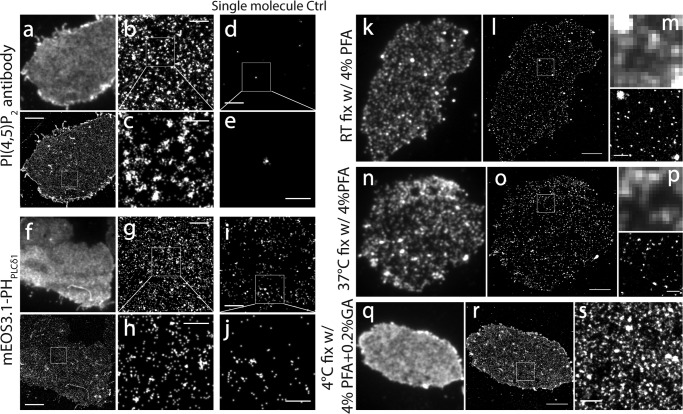FIGURE 3.
PI(4,5)P2 spatial organization in the fixed PM is sensitive to probe blinking and sample fixation conditions. a, TIRF and a corresponding superresolution image of the INS-1 cell membrane sheet immunostained with a monoclonal PI(4,5)P2 antibody and a secondary antibody labeled with Alexa Fluor 647. The samples were fixed with 4% PFA + 0.2% glutaraldehyde at 4 °C. b, cropped image corresponding to the box in a. c, enlarged image of the boxed region in b. Note the cluster structure in b and c caused by photoblinking. d and e, superresolution images of Alexa Fluor 647 molecules on a blank coverslip as a control of Alexa Fluor 647 single-molecule photobehavior. Note the fluorescence cluster artifact caused by Alexa Fluor 647 photoblinking in e. f–h, similar to a–c but using INS-1 cells expressed with mEos3.1-PHPLCδ1. i, superresolution image of mEos3.1 expressed at isolated single-molecule levels in a COS-7 cell using the deltaCMV promoter. Note the cluster structure of the mEos3 molecule caused by moderate photoblinking. k, TIRF image of an INS-1 membrane sheet fixed at room temperature and immunostained by a monoclonal PI(4,5)P2 antibody and AF647-conjugated secondary antibody. Note the abundant dense puncta visible under TIRF that were rarely observed in live cells. l, dSTORM superresolution image of PI(4,5)P2 in k. m, enlarged TIRF and dSTORM images in the boxed area in l. n–p, similar to k–m, but, with fixation at 37 °C, PI(4,5)P2 dense cluster artifacts were observed similarly. q–s, similar to k–m but fixed at 4 °C with 0.2% glutaraldehyde in addition to 4% PFA. The display contrast in q was different compared with other TIRF images to avoid saturation. Note the relative even fluorescence image and the enhanced fluorescence intensity under TIRF in q–s. Scale bars = 3 μm (a, f, i, o, and r), 500 nm (b, d, g, i, m, p, and s), and 200 nm (c, e, h, and j).

